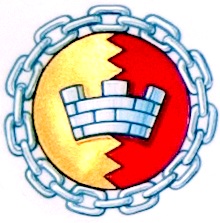Birmingham Civic Society

Badge, granted by the College of Arms by Letters Patent in 2008, which may be worn by all members of the society
|
|
| Formation | 10 June 1918 |
|---|---|
|
Region served
|
Birmingham, England |
| Website | www |
Birmingham Civic Society is a voluntary body in Birmingham, England, and is registered with the Civic Trust.
The society was founded at an inaugural meeting on 10 June 1918 in the Birmingham Council House. The first President of the Society, the Earl of Plymouth, addressed the assembled Aldermen, Councillors, Architects and other city worthies at that first meeting. He stated the aims of the Society, which were:
"to bring public interest to bear upon all proposals put forward by public bodies and private owners for building, upon the laying out of open spaces and parks, and generally upon all matters concerned with the outward amenities of the city and district. It will insist that taste is a thing that matters, and if any offence against taste is challenged at the outset, great good will be done, and converting of mean and unlovely parts of the City will gradually follow".
Sir Gilbert Barling Bt CB CBE was the Society's first Chairman and William Haywood was the first Secretary. Its principal objectives were the stimulation of historical interest in the city, the preservation of buildings and monuments of historic worth, the prevention of vandalism and the promotion of a sense of beauty and civic pride in the lives of citizens.
Immediately upon its foundation the Society received from an anonymous trust the sum of £15,000 (equivalent to around £596,000 in 2016) to buy land for open spaces, the land later to be vested in the Birmingham Corporation. As a result, several areas of land were purchased, transformed into parks and handed over to the City authorities. In most cases the Civic Society has retained until the present the right to be consulted about the management of these parks. Two notable parks in this gift were Kings Norton Park (25½ acres in October 1920) and Highbury Park (42 acres in 1923).
From its earliest days the Society has taken a prominent role in advising on and lobbying for improvements to the physical development of the city. This has progressed from 1919 when it lobbied for improvements to the (then) village of Northfield right up to the present. Often, the Society has commissioned its own plans for developments either at the request of the City Council or on its own initiative. In some cases, such as the refurbishment of the Chamberlain Memorial Fountain in 1978 and the creation of formal gardens in some city parks, it has provided the funding needed to bring about the developments in question.
...
Wikipedia
